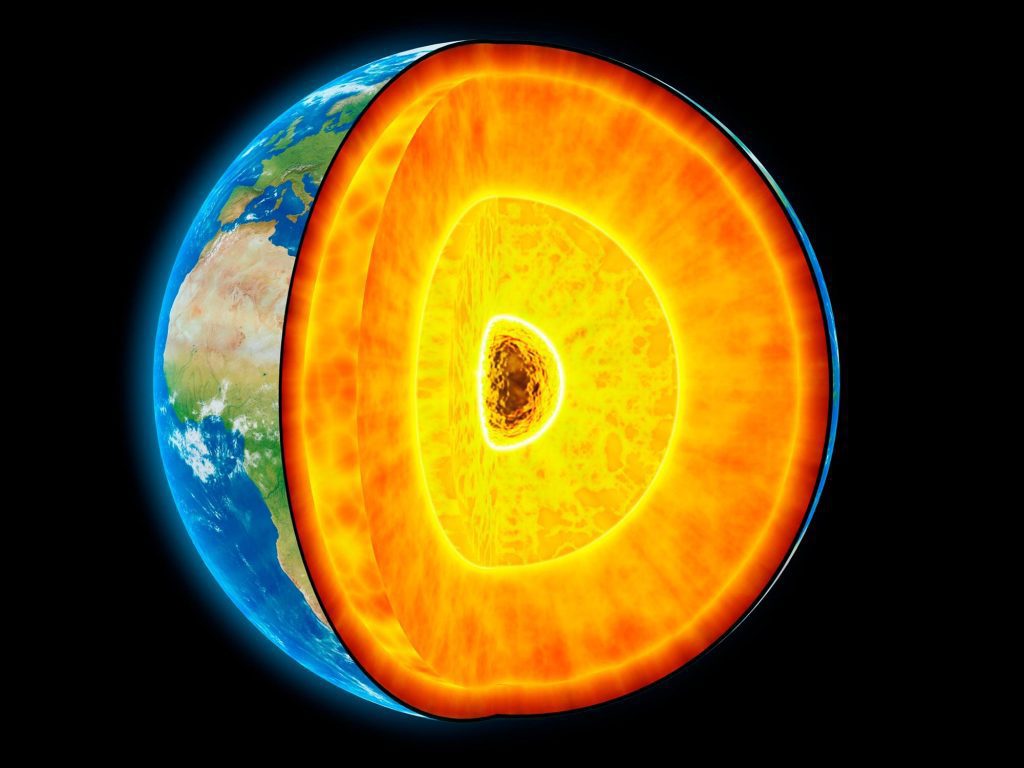

La variación de un segundo en el tiempo de viaje de un grupo de ondas sísmicas nos brinda una visión importante y sin precedentes de lo que sucede en las profundidades de la Tierra.
La teoría respalda nuestra comprensión de la convección en el núcleo externo de la Tierra y su función en el control del campo magnético del planeta. Los científicos no han observado directamente los flujos convectivos o cómo cambian. El geólogo de Virginia Tech, Ying Zhou, proporciona evidencia por primera vez.
Un gran terremoto sacudió la región de las Islas Kermadec del Pacífico Sur en mayo de 1997. Poco más de 20 años después, en septiembre de 2018, un segundo gran terremoto golpeó el mismo lugar, con sus ondas de energía sísmica emanando de la misma región.
Aunque dos décadas de sismicidad separaron los terremotos, debido a que ocurrieron en la misma región, se esperaría que enviaran ondas sísmicas a través de las capas de la Tierra a la misma velocidad, dijo Ying Zhou, geólogo del Departamento de Ciencias de la Tierra en Virginia Tech. Ciencias.

La ruta azul muestra una onda sísmica que penetra en el núcleo y se mueve a través de una región en el núcleo externo, donde la velocidad sísmica aumentó debido a la transmisión de un flujo de baja intensidad hacia la región. Crédito: Ying Zhou de Virginia Tech
Sin embargo, en los datos registrados en cuatro de las más de 150 estaciones de la red sísmica global que registran las vibraciones sísmicas en tiempo real, Zhou encontró anomalías sorprendentes entre los eventos gemelos. Durante el terremoto de 2018, un grupo de ondas sísmicas llamadas ondas SKS se movió aproximadamente un segundo más rápido que sus contrapartes de 1997.
Según Zhou, cuyos resultados se publicaron recientemente en
Blue lines are seismic rays in the outer core, where core-penetrating seismic waves moved through that region faster in 2018 than in 1997. Credit: Image courtesy of Ying Zhou
Scientists also have only been able to speculate about the source of gradual changes in strength and direction of the magnetic field that have been observed, which likely involves changing flows in the outer core.
“If you look at the north geomagnetic pole, it’s currently moving at a speed of about 50 kilometers (31 miles) per year,” Zhou said. “It’s moving away from Canada and toward Siberia. The magnetic field is not the same every day. It’s changing. Since it’s changing, we also speculate that convection in the outer core is changing with time, but there’s no direct evidence. We’ve never seen it.”
Zhou set out to find that evidence. The changes happening in the outer core aren’t dramatic, she said, but they’re worth confirming and fundamentally understanding. In seismic waves and their changes in speed on a decade time scale, Zhou saw a means for “direct sampling” of the outer core. That’s because the SKS waves she studied pass right through it.
“SKS” represents three phases of the wave: First it goes through the mantle as an S wave, or shear wave; then into the outer core as a compressional wave; then back out through the mantle as an S wave. How fast these waves travel depend in part on the density of the outer core that’s in their path. If the density is lower in a region of the outer core as the wave penetrates it, the wave will travel faster, just as the anomalous SKS waves did in 2018.
“Something has changed along the path of that wave, so it can go faster now,” Zhou said.
To Zhou, the difference in wave speed points to low-density regions forming in the outer core in the 20 years since the 1997 earthquake. That higher SKS wave speed during the 2018 earthquake can be attributed to the release of light elements such as hydrogen, carbon, and oxygen in the outer core during convection that takes place as the Earth cools, she said.
“The material that was there 20 years ago is no longer there,” Zhou said. “This is new material, and it’s lighter. These light elements will move upward and change the density in the region where they’re located.”
To Zhou, it’s evidence that movement really is happening in the core, and it’s changing over time, as scientists have theorized. “We’re able to see it now,” she said. “If we’re able to see it from seismic waves, in the future, we could set up seismic stations and monitor that flow.”
What’s next
That’s Zhou’s next effort. Using a method of wave measurement known as interferometry, her team plans to analyze continuous seismic recordings from two seismic stations, one of which will serve as a “virtual” earthquake source, she said.
“We can use earthquakes, but the limitation of relying on earthquake data is that we can’t really control the locations of the earthquakes,” Zhou said. “But we can control the locations of seismic stations. We can put the stations anywhere we want them to be, with the wave path from one station to the other station going through the outer core. If we monitor that over time, then we can see how core-penetrating seismic waves between those two stations change. With that, we will be better able to see the movement of fluid in the outer core with time.”
Reference: “Transient variation in seismic wave speed points to fast fluid movement in the Earth’s outer core” by Ying Zhou, 25 April 2022, Communications Earth & Environment.
DOI: 10.1038/s43247-022-00432-7







More Stories
¿Cómo se hicieron los agujeros negros tan grandes y rápidos? La respuesta está en la oscuridad.
Una vaca marina prehistórica fue devorada por un cocodrilo y un tiburón, según los fósiles
El lanzamiento del cohete Falcon 9 de SpaceX se ha detenido a medida que se acercan dos importantes misiones de vuelos espaciales tripulados.